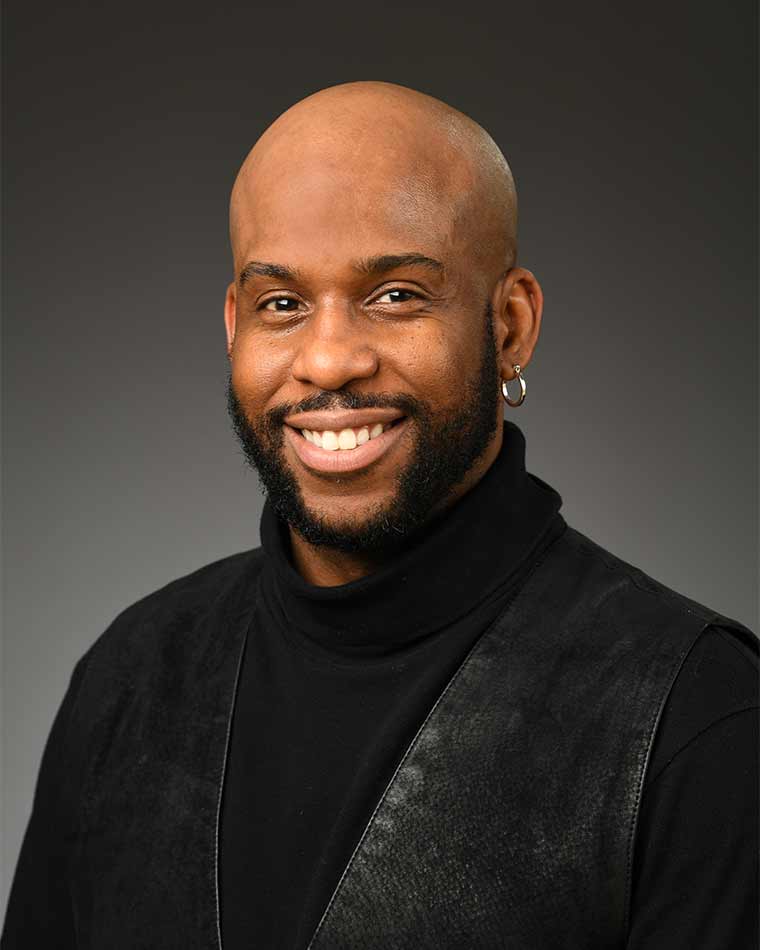BA, University of California, Los Angeles. MCM, University of Southern California, Annenberg School for Communication and Journalism. PhD (ABD), Stony Brook University. An emphatic purveyor of culture, aesthetics and the human condition. Research interests include visual culture, Afrofuturism, media and communications, gender and sexuality, arts education, subculture, postcolonialism, sartorial symbolism, queer studies, and social justice. SLC, 2018-
Undergraduate Courses 2019-2020
Literature
Doing It for the Culture: Journeys Through Revelation, Aspiration, and Soul
Open , Seminar—Year
Is it possible to teach or produce African American literature without discussing black identity, the African, or the experiences within the African diaspora? For students of literature and ethnic studies, “literature” can connote fine lines; but African American literature and those who write within it are writing within a specific history. Thus, how does the literature provide a space for sustaining the cultural traditions of African Americans, interracial relations, queer black bodies, blackness as pathology, and blackness as an Afrofuture? The class begins with Phillis Wheatley’s “On Being Brought from Africa to America,” or from the “Dark Continent,” as it was named by imperialists. Before we turn to America, we shall first turn to the African before she became African American. Throughout the semester, we will source and investigate the poetics of spirituals and visual culture that provoke the black experience in America. This course begins in the fall with a theme on “chains and freedom,” as we look to writings of the 18th- and 19th-century Afrofuturists; but the course will continue into the spring with a theme on Afrofuturism as a modern rumination of aspiration and possibility. During the spring component, we will endeavor to identify the impact of modern African American literature, visual culture, feminism, queer visibility, and class consciousness within hip hop culture. On thinking of Amy Sherald’s spectacular painting in the National Portrait Gallery, “Michelle LaVaughn Robinson Obama,” Sherald remarked that Mrs. Obama is painted in grayscale to represent the past, present, and future—simultaneously. We shall turn to the literature to understand more fully what that sentiment could mean for modern writers and artists who are greatly influenced by the blueprints left behind by the late and great writers and by artists who came before them.
Faculty
Related Disciplines
Previous Courses
African American Literature: Doing It for the Culture: Journeys Into Revelation, Aspiration, and Soul
Open , Seminar—Year
Is it possible to teach or produce African American literature without discussing black identity, the African, or the experiences within the diaspora? For students of literature and ethnic studies, “literature” can connote fine lines; but African American literature and those who write within it are created within a specific history. Thus, how does the literature provide a space for sustaining the cultural traditions of African Americans, interracial relations, queer black bodies, blackness as pathology, and blackness as an Afrofuture? The class begins with Joseph Conrad’s Heart of Darkness and the Congo Dialogues. Before we turn to America, we will first journey to Africa. Throughout the semester, we will read and understand the poetics of song and visual culture that provoke the black experience in America. African American literature is always in discourse with the relationships of Africans, blacks, and African Americans within the greater American society; thus, the authors are interpreted within a political conversation about the black body. In addition to the author, the reader is also in dialogue with the text and the modern world while simultaneously drawing upon the two. This course begins in the fall with a theme on “chains” as we look to writings of the 18th and 19th centuries, but the course will end in Afrofuturism—as a rumination. Perhaps African American literature is not only about the study of literature or poetics but also steeped within Afrofuturism. Better yet, let us turn to “High Priestess of Soul” Nina Simone in her reification of Work Song (Chain Gang): I’ve been working / And working / But I still got so terribly far to go. During the spring component, we will endeavor to identity the impact of modern African American literature, visual culture, and the poetics of hip hop. We will bridge the first semester with themes of Afrofuturism. In Amy Sherald’s spectacular painting of Michelle Obama for the National Portrait Gallery, she remarked that Mrs. Obama is painted in grayscale to represent the past, present, and future—simultaneously. We shall turn to the literature to understand more fully what that could mean for modern writers and artists who are greatly influenced by the blueprints left behind by the late and the great writers who created the genre.
